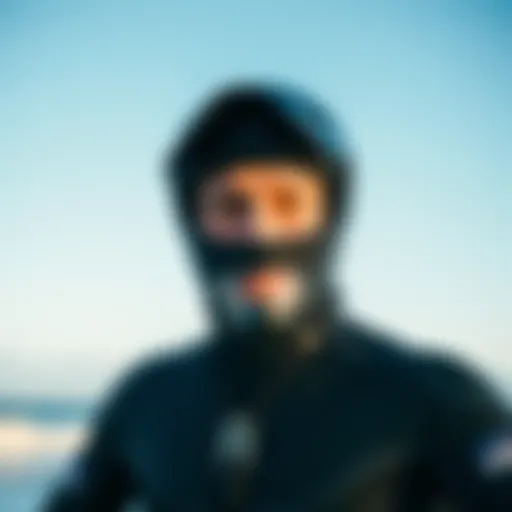Oahu Weather Map: Essential Insights for Kiteboarders
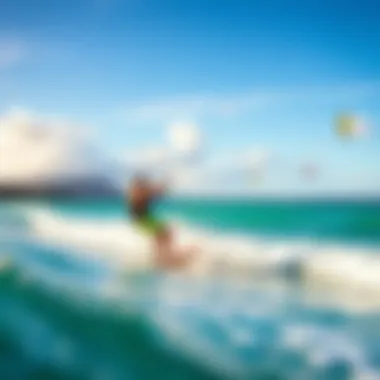
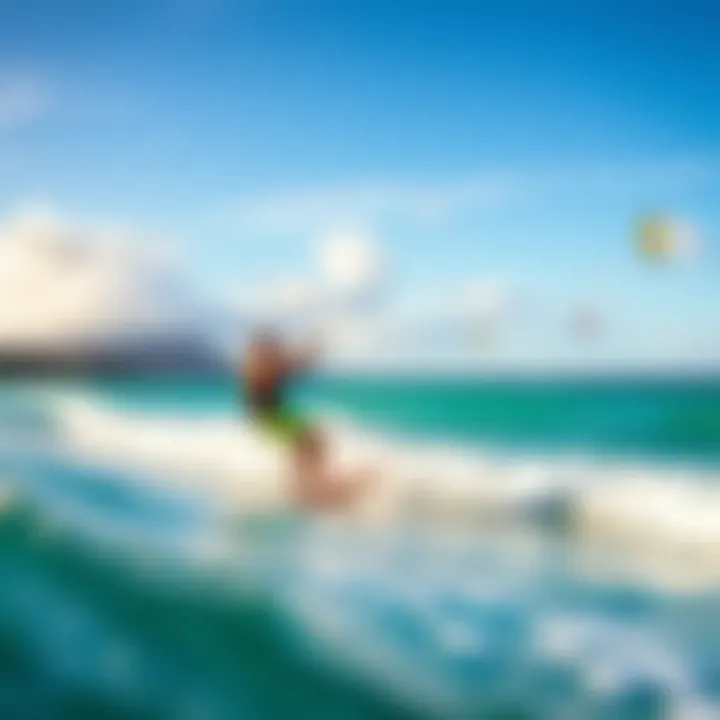
Intro
For those tempted by the allure of wind and surf, understanding Oahu’s weather can be the difference between a stellar kiteboarding adventure and a lackluster day on the water. Oahu boasts a complex weather system that varies not just by season, but also significantly by location. Whether you're a newbie willing to dip your toes in or a seasoned pro prepared to push your limits, having the right know-how can elevate your kiteboarding experience.
Wind conditions are the heartbeat of kiteboarding, and knowing how the islands' landscapes shape those winds is crucial. With rich topography, from the coastlines hugging the Pacific to the verdant mountains inland, Oahu creates its own microclimates that impact weather conditions in sometimes unexpected ways. This article is your passport to understanding those elements, so get ready to ride the winds of Oahu with confidence.
Gear Insights
Before you hit the water, let's talk about the essentials. Selecting the right gear ensures not only safety but also guarantees you have an enjoyable experience.
Latest Gear Reviews
In the fast-evolving world of kiteboarding, keeping up with the latest gear can feel like riding the wind at full speed. Here are some of the standout products that could enhance your sessions on the water:
- North Kiteboarding Reach: This kite is getting rave reviews for its versatility and stability, making it suitable for beginners and experts alike. Its lightweight design allows for easy handling in various wind conditions.
- Cabrinha Switchblade: Known for its powerful performance, this kite excels in diverse conditions, allowing riders to maximize their potential.
- Slingshot Refraction: Featuring ample pop and a smooth ride, it's ideal for those looking to nail their tricks.
Each of these products has its individual strengths, tailored for specific styles and conditions.
Essential Gear for Beginners
For those new to kiteboarding, acquiring some must-have gear can simplify the learning process:
- Kite: A reliable, user-friendly model reduces the initial learning curve.
- Board: A larger, more stable board can help balance as you find your footing.
- Harness: A comfortable harness is essential, enabling you to ride hands-free and control the kite effortlessly.
- Safety Leash: This secures the kite even if you lose control, adding a crucial safety measure.
As you grow into the sport, investing in a diverse range of gear tailored to Oahu's conditions will pay off.
Techniques and Tips
Kiteboarding isn't just about having the right gear; mastering the techniques is equally important. Understanding the wind patterns on Oahu can help improve your skills and awareness.
Advanced Tricks and Techniques
Once you’re comfortable with the basics, it can be beneficial to delve into some advanced tricks:
- The Kite Loop: An exhilarating trick that involves looping your kite in the air for added airtime.
- The Backroll: A stylish rotation that gives you flair while you surf the waves.
- Riding Blind: This trick requires you to look over your shoulder while riding in the opposite direction, showcasing your skill and control.
Safety Practices for Kiteboarders
Safety should be at the forefront of every kiteboarder's mind, especially in a dynamic environment like Oahu’s coast. Here are some key practices:
- Know the Weather: Constantly check real-time weather updates and forecasts.
- Respect Other Water Users: Always be aware of other surfers, swimmers, and fellow kiteboarders. Considerate riding is essential for everyone’s enjoyment.
- Wear Protective Gear: A quality helmet and impact vest can safeguard against falls or unexpected obstacles.
Staying informed and prepared can not only prevent accidents but also allow you to enjoy every moment on the water.
Remember: Kiteboarding is as much a science of understanding your environment as it is about riding the waves.
With this knowledge in hand, kiteboarders can not only improve their skills but also gain a deeper appreciation for the intricacies of Oahu's weather. By knowing when to ride, where to go, and how to set up their gear, enthusiasts can truly revel in the sport, making memories that last far beyond the shores of this stunning island.
Understanding the Weather Map
Weather maps serve as essential tools for kiteboarders looking to make the most out of their time on the water. These maps provide a clear picture of the atmospheric conditions over a given area, giving insights into wind patterns, temperature variations, and precipitation forecasts. Understanding these details can significantly enhance your kiteboarding experience, as choosing the right conditions can be the difference between a fun day on the water and a struggle against the elements.
Importance of Weather Maps for Kiteboarding
Before you even think about hitting the waves, you’ll want to check the weather map. This resource is crucial for kiteboarding enthusiasts, as it helps you avoid potential hazards and ensures you maximize your time on the water. By analyzing the weather maps, you can identify the best times to kiteboard based on wind speed and direction.
Here are a few reasons why these maps are invaluable for kiteboarders:
- Safety First: Knowing whether storms or high winds are on the horizon can keep you from dangerous situations.
- Wind Direction: Different kiteboarding spots favor specific wind directions. A good weather map will outline where the wind is blowing from, allowing you to pick ideal locations.
- Planning: Whether you are new to the sport or a seasoned rider, planning your outings based on weather maps means you can target locations with optimal conditions.
In short, the more you understand your weather map, the less chance you’ll be caught off guard.
Key Elements of a Weather Map
Weather maps can seem complicated at first glance but are actually quite straightforward when broken down. Here are some of the key elements you should look out for:
- Isobars: These lines represent areas of equal atmospheric pressure. When isobars are close together, expect stronger winds.
- Wind Arrows: These symbols indicate wind direction and speed. The longer the arrow, the stronger the wind.
- Temperature Contours: Color gradients will show you temperature variations across the island, guiding you on suitable clothing and gear to use.
- Precipitation Indicators: Understanding where rain is likely to fall allows for better planning, especially since you don’t want to kiteboard in a downpour.
By familiarizing yourself with these key components, you will be better equipped to interpret the weather map and make informed decisions that enhance your kiteboarding adventures on Oahu.
Geographical Overview of Oahu
The geographical makeup of Oahu plays an integral role in shaping the island's kiteboarding conditions. Understanding the different landscapes, including beaches, mountains, and prevailing winds, can significantly determine the optimal places and times to kiteboard. Kiteboarding isn’t just about having the right gear, but also about knowing your environment. Factors such as access, safety, and weather nuances associated with local geographies are crucial for both seasoned riders and beginners alike.
Main Kiteboarding Locations
Oahu boasts a variety of stunning locales ideal for kiteboarding, each influenced by its unique geographical features. Here are a few noteworthy spots:
- Kailua Beach: This location is popular for its steady trade winds, making it rather suitable for all skill levels. The sandy bottom and less crowded waters provide a pleasurable experience for kiteboarders.
- Lanikai Beach: Right next to Kailua, Lanikai is famous for its picturesque view and reliable winds. However, it's important to keep in mind that this area can get busy, especially during weekends.
- Makapu'u Beach: Known for its strong and often unpredictable winds, Makapu'u is mostly suited for advanced kiteboarders. The swell can challenge even experienced riders, offering a different kind of thrill.
- Waimanalo Beach: This spot is a gem for those seeking a laid-back atmosphere infused with wind and waves that are ideal for kiteboarding.Understanding the specific conditions of each of these areas can make or break a kiteboarding experience. For instance, while Kailua and Lanikai are relatively calm, they might not offer the same adrenaline rush as the robust courses at Makapu'u.
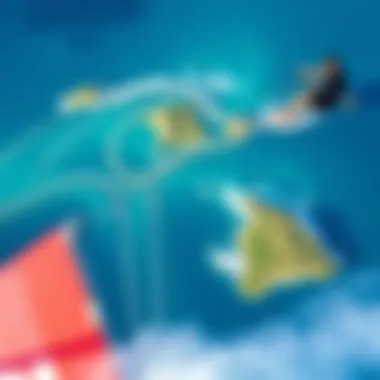
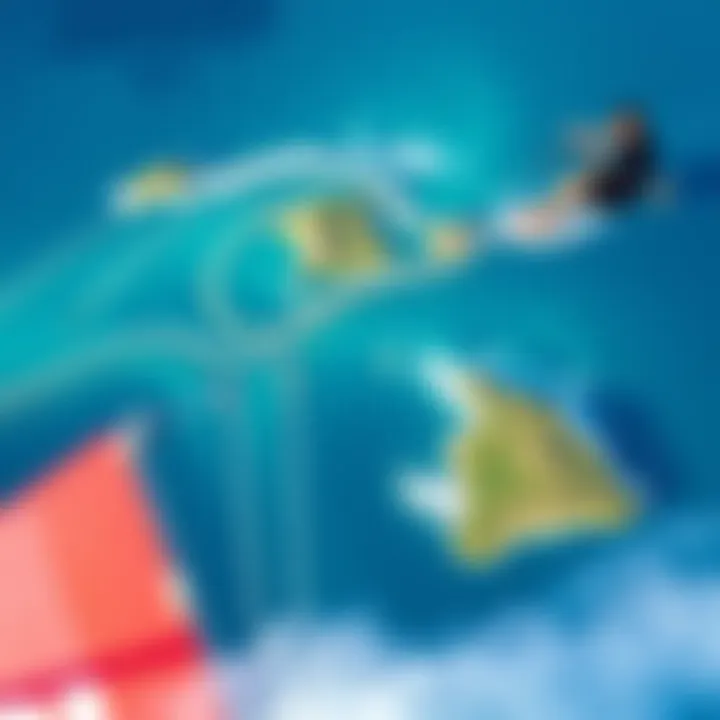
Topographical Features Influencing Weather
Oahu's topography is a vast tapestry intricately woven with mountains, valleys, and beaches that choose to cooperate or clash with the prevailing weather patterns. These features have a direct impact on kiteboarding as they can disrupt or enhance wind flow and even influence ocean currents.
- The Ko'olau Mountains: These volcanic ridges create a rain shadow effect. On one side, you might encounter lush greenery and consistent rainfall, while on the other, you find sunny skies and perfect wind conditions. An example is the wind patterns at Kaneohe Bay, where the strong trade winds funnel through the mountain passes.
- Diamond Head Crater: While visually stunning, this landmark also plays its part in influencing local weather. The top of the crater can act as a windbreak, with calmer conditions in the waters south of the crater contrasted against potentially gusty winds closer to the summit.
- Flat Shores versus Rocky Outcrops: The type of shoreline can greatly affect the waves and winds. Flat beaches like Kailua allow for easier launches, while rocky shores like Makapu'u might present challenges but also amazing waves.
Understanding these topographical details not only informs kiteboarders about where to go but also helps them anticipate how conditions might change throughout the day or between different seasons. Harnessing local knowledge combined with real-time weather updates can elevate anyone's kiteboarding game.
"Knowing every nook and cranny of Oahu doesn’t just amp up your ride; it could keep you safe out there on the water."
Equipped with geographic insights, kiteboarders can make informed decisions, ensuring they not only chase the wind but also do so in a safe and enjoyable manner.
Analyzing Wind Conditions
Wind conditions are, without a shadow of a doubt, at the heart of what makes kiteboarding exciting on Oahu. Understanding the various elements that influence wind patterns can elevate not only your kiteboarding skills but also your safety and enjoyment on the water. Kiteboarding relies heavily on wind for propulsion, and thus, analyzing these conditions is essential for making informed decisions on when and where to hit the waves.
Types of Winds in Oahu
Oahu is blessed with a variety of winds, each bringing its own flavor to the kiteboarding experience. Let's break down a few of the most notable types:
- Trade Winds: Predominant across the islands, these winds typically blow from the northeast. They’re reliable and create ideal conditions for kiteboarding, especially during the summer months.
- Local Wind Effects: As the sun heats different land areas, it can lead to thermal winds that vary in intensity and direction. For instance, the heat rising from the Waianae Range can generate localized winds beneficial for kiteboarders looking for a bit more bite.
- Southeast Swells: While these are more common in the fall and winter, they can occasionally generate strong winds that kiteboarders must watch for. The gusts can be exciting, but they also necessitate keen awareness of changing conditions.
Understanding these different wind types is crucial for selecting the right gear and preparing for varying kitesurfing conditions.
Wind Patterns by Season
Seasonal changes create distinct wind patterns that kiteboarders must know. Each season brings its own quirks:
- Winter: From December to February, winds tend to be stronger. This is the time when seasoned kiteboarders enjoy the thrill of riding in more challenging conditions.
- Spring: Winds often stabilize, providing a mix of moderate wind days. It's an excellent time for beginners to hone their skills in more manageable conditions.
- Summer: Trade winds dominate, usually providing consistent wind. This is when the beaches are alive with kiteboarding activities and competitions.
- Fall: Winds can be unpredictable as summer transitions into winter. There's a mix of moderate days and strong gusty conditions; a challenge that more advanced kiteboarders often relish.
Following these seasonal wind patterns closely can help you plan your trips effectively and maximize your riding hours.
Predicting Wind Changes
The ability to predict wind changes not only aids kiteboarders in making smart judgments on when to launch but also keeps them out of harm's way. Here are some pointers for staying ahead of the curve:
- Weather Apps: Utilize local weather apps like Windy or The Weather Channel to get real-time updates on wind conditions. These tools provide minute-by-minute forecasts that can be lifesavers for kiteboarders.
- On-site Observation: Nothing beats local knowledge. Observing the natural environment around kiteboarding locations, such as how the trees are swaying or ripples on the water, can offer clues about impending wind shifts.
- Advanced Forecasts: Pay attention to forecasts predicting frontal systems. Dramatic temperature drops often indicate changing winds, which can alter your plans for a day of fun on the water.
However, always remember that while technology is helpful, the ocean is a living environment, and conditions can change in the blink of an eye. Staying adaptable is the key to enjoying kiteboarding on Oahu.
"Wind conditions can turn from playful to problematic in mere moments, so keep your wits about you and respect the elements that make kiteboarding thrilling."
In summary, analyzing wind conditions is vital for kiteboarding on Oahu. From recognizing different wind types and predicting patterns throughout the year to using technology wisely, your knowledge will pave the way for fulfilling and safe kiteboarding adventures.
Temperature Variations Throughout the Year
Temperature plays a significant role in the kiteboarding experience on Oahu. Kiteboarders must be aware of how fluctuations in temperature throughout the year can influence their time on the water, affecting everything from wind conditions to water temperature. For instance, warmer months might contribute to stronger thermal winds, which many kiteboarders eagerly anticipate. Moreover, temperature affects not just the atmosphere but also the comfort and performance of kiteboarders. This section delves into the monthly temperature trends and discusses how these variations can significantly shape the kiteboarding conditions one might encounter on the island.
Monthly Temperature Trends
Oahu experiences a relatively stable climate, making the temperature somewhat predictable, but there are still notable monthly trends worth considering:
- January - March: During these winter months, temperatures range between 70°F to 80°F (21°C to 27°C). The cooler ocean currents can lead to crisper winds ideal for many kiteboarders seeking an invigorating experience, although cloud cover can sometimes dampen spirits.
- April - June: As spring slips into summer, temperatures gradually creep upwards, often reaching temperatures of 75°F to 85°F (24°C to 29°C). These months signal the onset of the trade winds, which come alive, providing favorable conditions for kiteboarding practitioners.
- July - September: Summer kicks into full gear, with temperatures regularly hovering between 80°F to 88°F (27°C to 31°C). The heat is palpable, and kiteboarding enthusiasts should be mindful of hydration as they glide across the water.
- October - December: As we transition back towards winter, expect mild temperatures ranging between 72°F to 82°F (22°C to 28°C). While the winds may begin to taper, this is still a favorable time for kiteboarders, especially towards the end of December when the trade winds sometimes re-emerge.
Understanding these monthly trends can empower kiteboarders to choose appropriate times for their outings effectively, keeping in mind personal comfort levels regarding heat and wind.
Impact of Temperature on Kiteboarding Conditions
The importance of temperature in the kiteboarding realm cannot be overstated. It directly influences both the wind dynamics and water conditions, which are vital for a kiteboarding adventure:
- Wind Strength: Higher temperatures can enhance thermal winds, offering a more consistent wind pattern, which is crucial for kiteboarders aiming for a solid riding experience. Kiteboarders will notice that during summer, the wind tends to be stronger and more reliable, while winter months might see variability that requires different techniques and gear.
- Water Temperature: Typically, as air temperature rises, water also warms up, creating more comfortable conditions for kiteboarders. Warmer waters might sometimes foster a conducive environment for longer sessions without the dread of chill setting in, thus enhancing the overall enjoyment and performance.
- Safety and Gear: With rising temperatures, one key aspect for kiteboarders is staying hydrated and aware of the gear they use. As the weather heats up, it becomes imperative to use appropriate sun protection, from sunscreen to light clothing, also choosing kite sizes capable of handling the stronger gusts without compromising safety.
Optimal kiteboarding on Oahu is not solely about catching wind but also navigating the interplay between temperature and conditions to maximize your adventure.
Recognizing these factors can assist kiteboarders, from novices to seasoned riders, in deciding not only when to kiteboard but how to prepare effectively based on the climatic changes throughout the year. The transition between seasons on Oahu unveils opportunities for splendid kiting sessions, urging enthusiasts to tailor their strategies accordingly.
Understanding Ocean Currents
When it comes to the art of kiteboarding, comprehending ocean currents is as crucial as mastering the wind. These currents can either assist or impede a rider's journey across the water, playing a significant role in both safety and performance. For kiteboarders navigating the waters of Oahu, understanding how these currents flow can make the difference between a thrilling ride and a turbulent struggle.
Oahu's ocean currents are influenced by various factors, including the trade winds, topography, and ocean temperatures. Each current can affect kiteboarding in unique ways, from altering the speed of the water to impacting wave formations that a kiteboarder might encounter.
Major Currents Affecting Oahu
Oahu is surrounded by several currents that shape its waters, with the most notable being the North Equatorial Current and the Kuroshio Current. These currents interact with local conditions to create dynamic kiteboarding environments.
- North Equatorial Current: This current flows from east to west, bringing warm water across the ocean. It has a direct influence on wave heights and ocean temperatures, which can impact kiteboarding conditions. Kiteboarders should be aware that the velocity of this current can increase wind speed, thus enhancing jump and trick opportunities.
- Kuroshio Current: Originating from the tropical Pacific, this warm current can influence the weather in Oahu significantly. Its warmth contributes to the stability of the wind patterns, offering consistent breezes that many kiteboarders seek. However, during certain seasons, it can create mixing waters that lead to unpredictable currents.
- Coastal Currents: Alongside these major currents, nearshore coastal currents also deserve attention. They are generally affected by local winds and tides, fluctuating in strength. Kiteboarders should monitor these currents closely because they can change depending on the time of day and tidal activity.
Understanding the currents allows kiteboarders to strategize their routes, enhancing both safety and enjoyment.
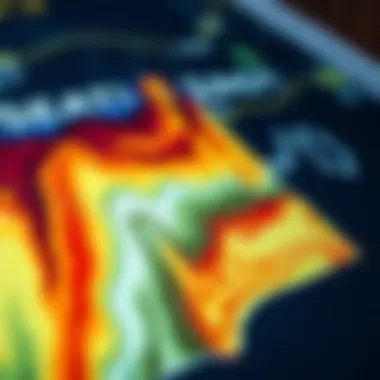
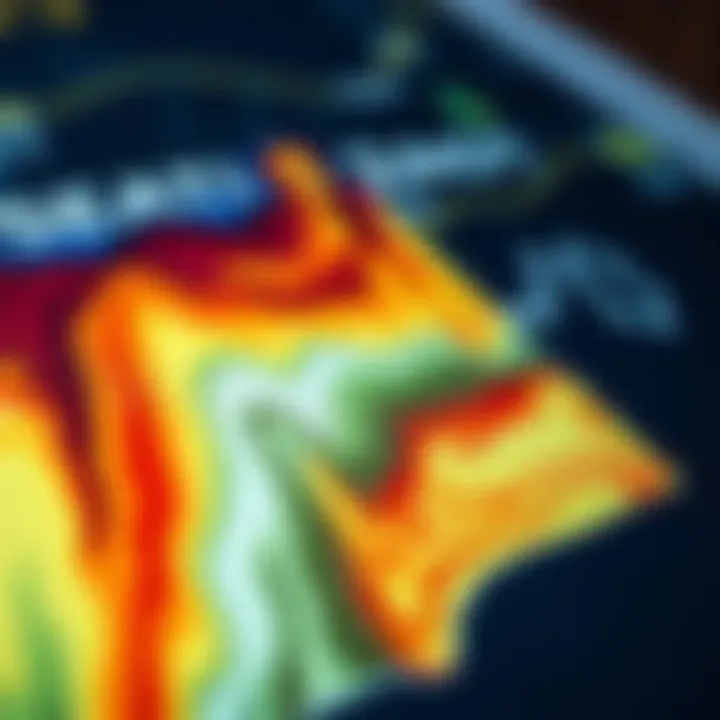
Current Patterns During Different Seasons
Current patterns on Oahu shift with the seasons, often dictated by the island’s unique climatic conditions. Kiteboarders need to adjust their approaches according to these changing patterns, as they can dramatically affect the riding experience.
- Winter Months (December to February): During this period, ocean currents tend to become more dynamic due to increased rainfall and storm activity. While winter can bring strong winds favorable for advanced kiteboarders, the currents can be treacherous for beginners. It's essential for novice kiteboarders to remain cautious and choose locations that are known for being safer during these months.
- Spring Months (March to May): As the weather warms, the currents start to stabilize, creating more predictable conditions. This is an ideal time for all skill levels, especially for those looking to hone their techniques without the high stakes of turbulent waters.
- Summer Months (June to August): The currents can be gentle and consistent, making this the prime season for kiteboarding in Oahu. The North Equatorial Current tends to exert more influence here, contributing to the ideal breezy conditions. However, beginners should still consider local advisories and seek out beginner-friendly spots.
- Fall Months (September to November): Similar to spring, the fall can offer stable conditions as the summer trade winds start to fade. A varied riding experience awaits during this period, with opportunities to encounter both calm waters and brisk breezes.
By familiarizing themselves with these patterns, kiteboarders can anticipate the conditions they might face on any given day, maximizing their enjoyment and enhancing their safety on the water.
Rainfall and Its Implications
Understanding rainfall is crucial for kiteboarding enthusiasts who want to enjoy the sport while making safety a priority. This section dives into how rainfall impacts kiteboarding conditions, from wind patterns to visibility, and what kiteboarders should consider when planning their sessions.
Rainfall Patterns Across the Island
Oahu's rainfall varies significantly across its landscape. The windward side, home to lush greenery and towering mountains, tends to receive more precipitation than the leeward side, which is drier and sunnier. This gradient is partly due to the trade winds blowing moist air from the ocean, which condenses into rain as it climbs the slopes of the Koʻolau mountain range.
- Windward Locations: Places like Kaneohe and Kailua can see upt to 60 inches of rain annually, especially during the winter months. This extra moisture can create turbulent conditions, so kiteboarders should be cautious.
- Leeward Locations: In contrast, Waikiki and Ko Olina welcome an average of 18 inches of rain per year, making them popular spots for kiteboarding throughout the year. Their stable weather patterns ensure reliable winds, even when the skies get cloudy.
"Understanding where and when it rains is half the battle in choosing the right spot to kiteboard safely."
Kiteboarders must also consider localized rain showers. These can pop up unexpectedly, often moving quickly. For example, you might be having a wonderful session in Makaha, only to find a downpour rolling in from the hills. Being aware of current and forecasted rainfall can save you from a soggy surprise.
Best Practices for Rainy Conditions
When the rains come, kiteboarding can still be a thrilling experience—as long as safety remains a priority. Here are some best practices to keep in mind:
- Monitor Local Forecasts: Make it a habit to check the weather apps or websites, like NOAA or Weather.com, before heading out. Real-time updates can inform you about sudden rain changes.
- Avoid High Winds: Rain often accompanies strong winds. It’s best to avoid extreme gusts, as these can drastically affect your control over the kite. Stick to ideal wind conditions to ensure a safe ride.
- Gear Up Appropriately: If you're expecting rain, consider wearing a lightweight waterproof jacket to stay dry and comfortable. Additionally, having a spare towel and change of clothes on hand can make the day much more enjoyable.
- Stay Close to Shore: In rainy conditions, visibility can drop rapidly. Always kiteboard close to the shore, where you can quickly return if needed. Plus, it’s easier to spot incoming rainclouds from land.
- Respect the Environment: Finally, if storms are brewing on the horizon, it’s best to postpone your session or head in early. Safety comes first, and the ocean’s conditions can change in the blink of an eye.
Incorporating these strategies will give kiteboarders the confidence to tackle rainy weather head-on. Understanding rainfall not only enhances your kiteboarding experience but also ensures safety and enjoyment on Oahu's unpredictable landscape.
Microclimates of Oahu
Understanding the microclimates of Oahu is crucial for kiteboarding enthusiasts who seek to optimize their time on the water. While Oahu is generally known for its beautiful beaches and consistent winds, the island has various localized weather patterns that can affect kiteboarding conditions significantly. These microclimates are influenced by factors such as elevation, proximity to the ocean, and surrounding vegetation, leading to differing winds and temperatures even within short distances.
One of the primary benefits of recognizing these microclimates is that it allows kiteboarders to choose the right spot based on current weather conditions. Kiteboarding can be exhilarating, but it also demands a thorough understanding of the elements at play. Ignoring the microclimates could lead to chasing wind or waves in conditions that don’t suit one’s skill level and could potentially result in mishaps. This awareness acts as a guiding star for both novice and seasoned kiteboarders.
Understanding Kitesurfing Spots with Unique Microclimates
Oahu boasts numerous kitesurfing spots, each with its own unique microclimate. For example, Kailua Beach is renowned for its lighter, more consistent winds which make it ideal for beginners and intermediate kiteboarders. Conversely, the North Shore can experience more variable wind conditions due to the surrounding mountains, creating gusty conditions that appeal more to advanced riders looking for a challenge.
Some key kitesurfing spots with distinct microclimates include:
- Kailua Beach: Known for steady trade winds and flat water, excellent for learners.
- Makani Kai: Offers offshore breezes that create smooth and clean riding conditions, favored by experts.
- Kanaha Beach Park: Features diverse conditions where winds can shift, making it a spot where one needs to stay alert and observe.
By understanding these differences, kiteboarders can save time and enhance their experience, ensuring they’re at the right place at the right time. The ability to read these microclimates implies not only skill in kiteboarding but also a deeper appreciation for the island's ecology.
Local Knowledge and Experience
When it comes to kiteboarding in Oahu, there’s no substitute for local wisdom. While weather apps offer useful data, conversations with seasoned kitesurfers can provide insights that no app can replicate. Locals know the quirks of specific spots—the wind patterns, how the currents shift at different times of day, and even the best places to avoid when the weather turns.
This local knowledge includes:
- Preferred Times: Certain times of the day may yield better wind conditions or tidal influences.
- Weather Nuances: Experienced riders often discuss how local flora and fauna can indicate changes in wind conditions, something that’s overlooked by casual visitors.
- Safety Tips: Knowledge about shark sightings or sudden weather changes can keep kiteboarders safe.
Engaging with the local kiteboarding community opens doors to invaluable tips that can be the difference between a great day on the water and an unfortunate mishap. Websites like Reddit or local Facebook groups frequently discuss kiteboarding experiences and tips specific to Oahu, making them excellent resources for anyone looking to learn more.
"The best weather predictions don’t come from apps but from those who have watched the island for years. Always ask the locals."
Accessing Real-time Weather Information
For any kiteboarding enthusiast, staying on top of the weather is non-negotiable. Real-time weather data can mean the difference between an exhilarating ride and a jarring experience. Accessing accurate and timely information not only ensures safety but enhances the overall kiteboarding experience. Oahu's weather can shift quicker than one might think, and having the right tools at one’s fingertips allows kiteboarders to make smart choices, minimizing risks associated with sudden changes in conditions.
The beauty of modern technology means that there are various avenues to obtain this crucial information. Reliable sources can provide up-to-the-minute updates on wind speed, direction, and potential weather disruptions, ensuring that riders are prepared for whatever Mother Nature throws their way.
Reliable Weather Apps and Websites
When it comes to real-time weather information, the selection of apps and websites is vast. However, not all sources are created equal. Here are a few that stand out, trusted in the kiteboarding community:
- Windy: This app offers an interactive weather map that allows users to track wind patterns, temperature, and precipitation in real-time. The animations are intuitive and provide a clear picture of what to expect.
- KiteMetric: Specifically designed for kiteboarders, it aggregates data from various sources, allowing users to personalize settings based on their preferred conditions.
- Magicseaweed: Primarily known for surf forecasts, it also caters to kiteboarders with detailed wind statistics and tide data essential for planning.
- NOAA: The National Oceanic and Atmospheric Administration offers accurate forecasts that are vital for understanding local weather patterns. Their website provides comprehensive data that is especially reliable for enthusiasts in coastal areas.
- Windfinder: Focused solely on wind conditions, this website gives forecasts that are incredibly specific. It also includes wind alerts, making it a handy tool right before heading out.
Using these platforms means riders can filter information based on location, ensuring they scout out the best spots for their skill level and conditions.
Local Forecasts and Reports
While apps and websites are great for an overview, nothing beats local knowledge. Forecasts and reports from local kiteboarding shops and instructors can provide insight that national services can miss. They often have their finger on the pulse of immediate changes in weather patterns, thanks to their experience and day-to-day observation.
Consider engaging with:
- Kiteboarding Schools: Many schools actively maintain their own forecasts based on reliable local observations. Following their social media accounts or newsletters can keep enthusiasts informed, creating a community of shared knowledge.
- Local Forums and Groups: Websites like reddit.com/r/kiteboarding often feature discussions on recent conditions and wind patterns experienced by local kiteboarders. Engaging in conversations there can yield real-time insights that are invaluable.
- Weather Stations: Some local shops maintain weather stations that directly monitor conditions in their vicinity. This data often feeds into broader forecasting tools, ensuring up-to-the-minute information.
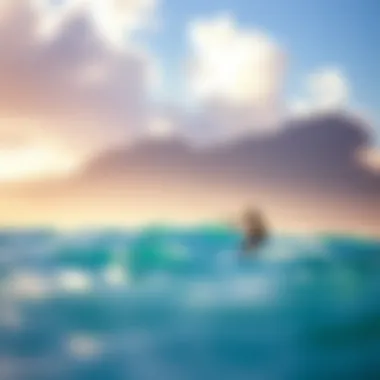

Staying connected with these resources not only enhances safety but also builds a strategy for an enjoyable day on the water. After all, flexibility in plans is critical, and having the right intel makes all the difference.
“It’s not just about getting the wind right; it’s about reading the ocean and the skies.”
In summary, accessing real-time weather information is a cornerstone of kiteboarding successfully on Oahu. Combining technology with local insights creates a robust safety net, allowing kiteboarders to enjoy the waves with confidence.
Preparing for Kiteboarding Based on Weather
Kiteboarding is not just about having the right gear; it’s deeply intertwined with understanding the weather. Weather patterns, wind directions, and seasonal changes all come together to create conditions that can enhance or hinder one’s kiteboarding experience. For enthusiasts, knowing how to read weather maps and predictions could be the difference between an exhilarating day out on the water and a frustrating one stuck in poor conditions. The following sections will delve into crucial aspects of preparing for kiteboarding by examining weather conditions, giving kiteboarders a solid footing to make informed decisions.
Assessing Safety Conditions
Safety in kiteboarding cannot be overstated. Adverse weather can lead to dangerous situations, turning an enjoyable outing into a precarious endeavor. Here are several key factors to consider when assessing safety conditions:
- Wind Strength and Consistency: Before heading out, check the wind forecast. Wind speeds ideal for kiteboarding vary by skill level. A good rule of thumb is that beginners should avoid winds over 20 miles per hour, while intermediate to advanced kiteboarders may handle stronger winds with ease.
- Storm Warning: Keep an eye on storm systems. Even if conditions seem clear, sudden changes can arise. It’s essential to stay updated on weather alerts through reliable resources like NOAA (National Oceanic and Atmospheric Administration) or local news apps.
- Water Conditions: Assess the water state. Factors such as tide levels and current strength can significantly influence safety. Areas with heavy currents can create unpredictable challenges, particularly for less-experienced kiteboarders.
Regularly checking these elements can safeguard not only your own experience but also that of fellow kiteboarders.
Ideal Weather Conditions for Beginners vs Advanced Kitesurfers
Understanding the right conditions for your skill level is paramount to maximizing enjoyment and safety when kiteboarding. Here’s a breakdown of what to look for:
Beginners
Newcomers should aim for:
- Gentle Winds: Ideally between 10 to 15 miles per hour.
- Flat Water or Light Waves: Perfect for practicing control.
- Clear Skies: Cloudy weather can indicate changing conditions, which can be tricky for novices.
Advanced Kitesurfers
On the other hand, seasoned kiteboarders often look for different scenarios to challenge themselves and push their limits:
- Stronger Winds: Ranging from 15 to 25 miles per hour is mostly preferred.
- Choppy Water or Bigger Waves: These conditions are great for jumping and other tricks.
- Paying attention to local spots: Different areas might have unique features, like sandbars or wind tunnels, adding to the excitement.
In essence, whether you're just starting out or looking to catch some serious air, recognizing what weather signifies which conditions is crucial for an effective and safe kiteboarding experience.
Influence of Climate Change on Oahu's Weather Patterns
Understanding the impact of climate change on Oahu's weather is crucial, especially for kiteboarding enthusiasts. Not only does it alter typical wind patterns and seasonal temperatures, but it also has significant implications for water conditions—both of which are vital for safe and enjoyable kiteboarding. As the island faces ongoing changes in climate, kiteboarders must stay informed about variations that could affect their experience on the water.
Long-Term Weather Changes
The long-term effects of climate change are gradually morphing Oahu’s weather landscape. Researchers are starting to note variations in rainfall patterns, with wet seasons becoming increasingly erratic. Some areas may experience heavier rainfall, while others suffer from dry spells more consistently than before. Such fluctuations can lead to unexpected conditions, often leaving kiteboarders scrambling to adapt.
Temperature increases are also noticeable, with certain months seeing record highs. This can change not only the overall experience for kiteboarders due to extreme heat but also affect water temperatures, potentially affecting marine life and, in turn, the ecological health of the spots where kiteboarders often ride.
Moreover, coastal erosion has become a pressing issue due to rising sea levels, which further threatens the accessibility of some kiteboarding spots.
"Climate change isn’t a distant threat—it’s here, and it's influencing our everyday experiences."
Future Projections for Kiteboarding
Looking ahead, predictions suggest kiteboarding in Oahu may face both challenges and opportunities. With continuing shifts in wind patterns, some areas may become more favorable for kiteboarding, exhibiting stronger and more favorable winds during previously typical calm periods. According to various climate models, certain locations might emerge as new hotspots for kitesurfing, providing a silver lining.
However, kiteboarders must also prepare for the reality that not all changes will be beneficial.
- Weather Uncertainty: More unpredictability could mean quick decisions regarding when to hit the water.
- Increased Temperature: Kiteboarders might find themselves needing to adapt their gear to tackle hotter conditions, such as choosing lighter suits and staying hydrated more vigilantly.
- Safety Considerations: Changes in wave patterns and enhanced intensity of storms, possibly leading to rougher waters, need thorough examination and caution for adventurers.
By understanding these potential shifts, kiteboarding enthusiasts can better prepare and possibly adjust their plans, ensuring they catch optimal conditions while prioritizing safety.
Finale and Recommendations
In closing, it's essential to recognize the wide array of factors that significantly impact kiteboarding on Oahu. As we sift through the details discussed in this guide, kiteboarders can find themselves better prepared to tackle the majestic waves and winds that the island offers. The collective insights regarding wind conditions, temperature variations, ocean currents and local microclimates serve as a treasure chest of knowledge that can elevate any kiteboarder’s adventures.
Here are a few key takeaway points from this article:
- Wind Patterns: Understanding the predominant winds throughout the year can greatly enhance your sessions. Familiarize yourself with local terminology like "Trade Winds" and " Kona Winds" as they can make or break your ride.
- Seasonal Trends: Each season brings unique challenges and opportunities. Take note of the monthly trends; winter might offer gusty conditions, while summer brings steadier breezes.
- Microclimates: Oahu is a patchwork of diverse weather zones. Spotting where to kiteboard based on microclimates can lead to some fantastic days out on the water. Thorough exploration of local beaches, such as Kailua and Lanikai, could just reveal the perfect hidden gem.
- Real-time Data: Depend on weather forecasting tools and apps to get the latest updates. Websites such as Windy.com or NOAA provide timely, accurate information.
The balance between knowledge and experience is crucial for both novice and experienced kiteboarders. Emphasizing preparation can be the difference between a spectacular day on the water or a disappointing one.
Summarizing Key Insights
This article has elucidated the crucial elements to be aware of when kiteboarding on Oahu. By understanding local weather conditions and their fluctuations, the kiteboarding community can maximize their enjoyment in the waves. Wind can transform from gentle breezes to fierce gusts, and local microclimates can greatly affect conditions on the water. Therefore, always take the weather map seriously.
Kiteboarding is not only a sport, it’s an experience, a dance with nature. Adapting to what the elements provide can make the difference. The joy of kiteboarding comes not just from harnessing the wind, but from each unique experience at various spots around Oahu.
"Knowledge is the lighthouse that guides the kiteboarder through the rough seas of unpredictability."
Encouraging Responsible Kiteboarding Practices
As kiteboarding enthusiasts, we must also embrace our roles as stewards of the environment. This sport does not exist in a vacuum; it intermingles with the delicate ecosystems of Oahu.
- Respect Local Regulations: Always be mindful of local rules regarding kiteboarding, which can change based on environmental assessments or community input. Make it a habit to check local guidelines before hitting the water.
- Consider Safety: The arrangement of your kitesurf gear should prioritize your safety and that of other beachgoers. Ensure all equipment is in working order and always be aware of your surroundings.
- Environmental Considerations: Educate yourself about the local wildlife and ecosystems. Keep certain beaches pristine by picking up litter or not disturbing marine life.
- Community Engagement: Join local kiteboarding groups or forums, like those found on Reddit or Facebook. Sharing insights, lessons learned, and best practices can cultivate a strong, responsible kiteboarding community.
In essence, a solid understanding of the weather patterns paired with responsibility ensures that kiteboarding remains not just enjoyable, but also sustainable for future generations.







